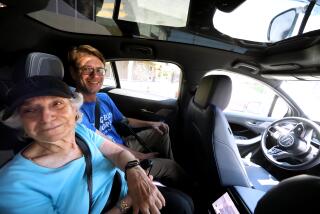Immortality as a Matter of Fax : GREAT MAMBO CHICKEN AND THE TRANSHUMAN CONDITION Science Slightly Over the Edge<i> By Ed Regis (Addison-Wesley: $18.95; 300 pp.) </i>
Are you worried that you might not have enough time to experience everything you wanted to? Keith Henson, a lapsed graduate student of astronomy and ringleader of a society of techno-wizards obsessed with space travel, thinks he has figured out how to do it.
Simply copy the contents of your mind--that is, your essential self--onto a computer disc. Make billions of copies of the disc and Fax them out in all directions into the cosmos. After these billions of copies of you have traveled long and far enough to experience everything there is, throw a huge party somewhere in space, so all your selves can get back together and compare notes.
The only problem you’d have to solve would be getting enough bean dip for the party, says Henson, one of the characters in this freewheeling, riotously funny group profile of a dozen or so visionaries who are working toward making privately funded space shots an economic reality. These men and women, mostly well-credentialed scientists and engineers, don’t simply want to joy-ride among the stars. They want to colonize space--without the dubious help of NASA--and live there permanently.
A few of the other free-enterprise astronauts are Bob Truax, the ex-Navy pilot who built the rocket in which Evel Knievel tried to jump the Snake River canyon in 1974; Gerard O’Neill, the Princeton physicist who in the 1970s launched the idea of building space colonies from materials mined on the moon; George Koopman, a rocket engineer and Hollywood stunt producer who dropped a Ford Pinto 1,500 feet into the Chicago River for the John Belushi movie “The Blues Brothers,” and 1960s LSD guru and former Harvard psychology professor Timothy Leary, who later became an enthusiast of space colonies.
The chronicler of these merry pranksters of science, Ed Regis, wrote the highly acclaimed 1987 book, “Who Got Einstein’s Office?,” a comic, factually accurate history of Princeton’s distinguished but kooky Institute for Advanced Study. “Great Mambo Chicken” overlaps the previous book in that radically imaginative physicists populate both works. But in the latest book, Regis moves from the center of the scientific establishment to its outermost fringe.
The Great Mambo Chicken of the book’s title shows how short the distance between the center and the fringe of science can sometimes be. The eponymous chicken was made in the 1970s, Regis tells us, presumably with government funding, at the Chronic Acceleration Research Laboratory at UC Davis. The chicken in question (actually there were several) was subjected to more than twice the normal force of gravity for six months, then tested for chicken-style athletic performance. Regis reports that it scored extraordinarily high, with a three-fold gain in both muscle power and bone strength.
“But,” asks author Regis in his exuberant, heavily italicized style, “What was it good for?” The answer is suggested by the second element in the book’s title: “The Transhuman Condition.” Great Mambo showed the researchers how humans might develop if they lived in a greater-than-normal G forces--in a star ship, say, cruising the galaxies and looking for a place to settle.
Exploring deep space in an interstellar vehicle, Regis tells us, turns out to be only an intermediate stage for the book’s cosmic prophets. What they really have in mind is for each voyager to experience--physically, not mystically--infinity and eternity. In Regis’ words, the transhuman condition would be achieved when human life “would have gone everywhere, done all things , and so on. . . . When all this happened . . . life would have brought the entire physical universe to a state of self-awareness. It would have transformed a dead cosmos into a living, thinking entity. And that would be the end.”
The way to reach that apocalypse, Regis tells us, is a matter of profound disagreement among the book’s loosely knit tribe of fanatic star-colonizers. One faction favors a biological and mechanical approach, while their opponents prefer pure digital electronics for attaining the ultimate condition.
Members of the first faction (none of them academically affiliated biologists) are now, according to Regis, trying to buy time for science to overcome the enormous physical obstacles to interstellar travel. They place their hopes in cryogenics--the freezing of human bodies (or, for the budget-conscious, just the head, or “neuro”) immediately after death. The problem with this approach, Regis notes, is that water expands when it freezes, rupturing tissue. To repair the damage, the engineers in the group are trying to develop so-called nanotechnology--armies of microscopic, self-replicating robots capable of, among myriad other feats, repairing individual cells in the body.
The opposing group says cryogenics and tiny technology will take too long to pay off. To streamline the process of launching themselves into space, they hope to leave their bodies behind altogether and “download” their minds, cell by cell, into a computer. From there, they propose, their minds could be Faxed to the stars.
Author Regis faces a daunting technical problem of his own in this book, namely, to hold this unruly cast of characters and ideas together and make them march in the same direction long enough to produce a story. Given his subject matter, a linear narrative wouldn’t do.
Instead, Regis builds the book as a composer would develop a complex symphony out of a relatively simple theme. He begins by painting a contrasting small group portrait of cryogenicist Kent, downloader Moravec, and rocket engineer Truax. From there he spirals out, in ever-widening circles, to include ever more people and ideas until, at the book’s end, he has the reader breathless and goggle-eyed. Regis builds tension by prying the reader’s mind open with successively more imaginative notions, relieving the tension with comic-relief anecdotes about the characters’ lives, such as breast-feeding at NASA meetings, detonating “recreational” explosives in the Arizona desert and keeping goats as house pets.
Regis is trained in classical philosophy, a fact that manifests itself rarely and unobtrusively in “Great Mambo Chicken and the Transhuman Condition,” but which helps him get his arms around the cosmic notions of the characters he presents. (In Plato’s “Republic,” Socrates advises his students to study cosmology in order to prepare their minds for the heavier demands of philosophy.) His deep intellectual empathy, combined with his lucid, energetic prose, provides even the most scientifically illiterate reader with an irresistibly transparent window on this remarkable group of people.
The book is, quite simply, a tour de force. To apply poet Ezra Pound’s definition of a good book, “Great Mambo Chicken” is a ball of light in the hand. Regis is one of the most exciting nonfiction writers in this country today.






